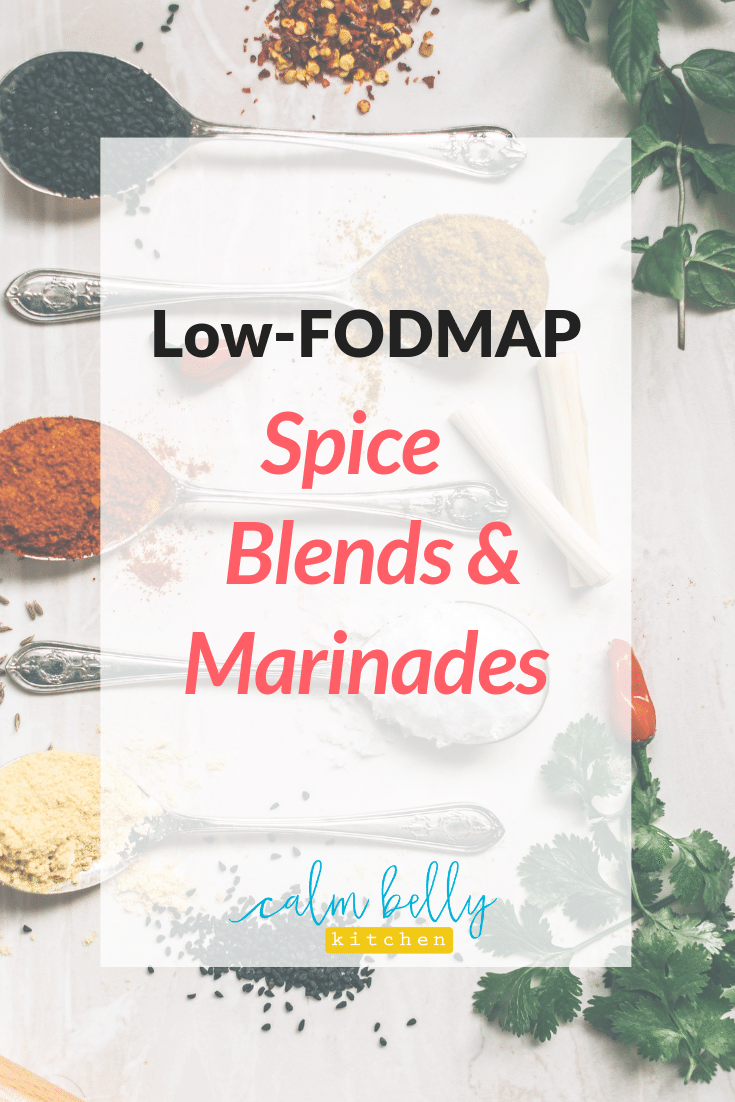Do us a favor...Share on Pinterest!
The FODMAP Diet is a lot of things:
It’s effective
It’s enlightening
It’s backed by research
One thing it’s NOT--at least according to most people--is easy.
Most of us get really excited when we learn there’s a safe way to control IBS symptoms with diet. But then we dig a little deeper…
...and suddenly we’re confused and overwhelmed.
It’s true that the FODMAP Diet has its challenges. I promise they get easier over time, but I’d rather help you shorten that learning curve instead of figuring things out on your own.
To do that, I surveyed members of the Calm Belly Kitchen community asking, “What is your biggest struggle when it comes to the FODMAP Diet?”
With over 100 responses, the same things kept coming up again and again. They’re also the same struggles I’ve seen working with IBS sufferers since 2015.
Today, I’m revealing the top 4 most common challenges that come with the FODMAP Diet along with my best tips to overcome them. These tips haven’t just worked for me--They’ve helped hundreds of clients and community members to improve their symptoms faster, and without the struggle.
I'm guessing you’ve experienced at least one of these challenges, so let’s get started!
>>> Ready to tackle FODMAP? Check out our FODMAP ebooks designed to save you time and get you feeling better fast!
Onion and Garlic Are In Everything
Well, maybe not everything, but it seems like they're in everything! Especially if you're eating out or you're not preparing the food yourself.
The easiest solution for replacing garlic is to drizzle garlic infused oil over your food to get that familiar flavor. The reason garlic infused oil is low FODMAP is because it not fat soluble. In other words, the FODMAPs in garlic cannot cross over into fats, only into water-based liquids.
So, if you put garlic in a soup and simmer it, then you take out the garlic, that soup still contains FODMAPs from the garlic.
As far as replacing onion, you can use the green parts of leeks or scallions (the white parts contain the bulk of the FODMAPs). Leeks have amazing oniony flavor--I think they’re tastier than actual onions.
Check out my Ultimate Guide to Flavor without onion and garlic for tons more ideas to create flavorful meals without those two ingredients.
Eating Out
Even though I’m not listing these common struggles with the FODMAP Diet in any particular order, if I were, this would be number one.
And sure you could stay in your house preparing every single meal, but in reality that’s just not practical (or fun). In light of that, here are my top 3 tips for handling restaurant meals when you’re on the FODMAP Diet:
1. Research menus online
Just about every restaurant has their menu on the web, so you probably tried this strategy already...but stick with me. I have a ninja tip that can take your menu research to the next level.
This tip works best at restaurants that serve a specific cuisine--Greek, sushi, Italian, Chinese...you get the picture. The majority of these restaurants serve the same classic dishes. You’ll always find California Rolls at a sushi restaurant or Orange Chicken at a Chinese restaurant, for example.
Here’s what you do: Let's say you're going to a traditional Italian restaurant. Pick out two or three classic dishes--perhaps Chicken Marsala or Chicken Picada--that you think could work, and google the recipes. Pick the best two or three results and take a look. Reading recipes will give you an idea of the common ingredients that are typically included in each dish.
With this method, you know if something is definitely not going to work for you, or if it looks like it could be modified. That way you have some options ready, and you know the questions you're going to ask when you get to the restaurant.
2. Eat at Chain Restaurants
If you’re not a fan of chains, give me a minute to explain…
Most chain restaurants do a lot of training for their staff around dealing with customers with food allergies and food sensitivities. They make sure their managers and staff take food intolerances seriously and know how to work with you to find something that you can eat. They make it part of their corporate culture because their restaurants thrive on word of mouth.
In other words, they don't want to have their reputation ruined because they sent someone to the hospital with a deathly peanut allergy.
When I say chain restaurants, the best options are usually sit-down restaurants like Maggiano's or Cheesecake Factory or TGIF Fridays because they still do a lot of the food prep on sight and have the ability to make modifications.
3. Make the server your ally
This last tip is the easiest to do, and it all comes down to this basic truth: People like to play the hero.
Most servers enjoy interacting with customers and welcome an opportunity to go above and beyond. They get your gratitude, which feels good, and most people are happy to tip for extra-helpful service (As a former waitress in college, I definitely recommend it!).
So don’t hesitate to ask them questions about the menu, or to explain that you can’t eat certain foods. Ask them to check with the kitchen about ingredients, or ask them to suggest something you can modify.
Of course, there’s always the possibility of running into a bad mooder of a server, but that’s the exception--especially when you treat them as an ally rather than an adversary.
Portion Control
Knowing how much of any food you can or should eat is a very common cause for confusion--and with good reason. Let me explain…
If you're using the Monash FODMAP app, you can look up the low-FODMAP serving size for any food in their database. Where it gets tricky is knowing if you can eat MORE than a single serving.
Luckily, there’s no need to be hungry on the FODMAP Diet.
Most importantly, you should know that there are many foods you can eat freely (provided you’re not eating to the point of feeling uncomfortably stuffed, which is another way to trigger symptoms).
Let’s look at rice, for example. One serving of white rice is listed at 1 cup cooked, or 190 grams. But if you’re really hungry, it’s perfectly okay to eat more than 1 cup of rice because there is no “upper limit” for rice.
What do I mean by “upper limit”?
Some foods cross over into the high-FODMAP zone when you eat larger amounts. These upper limits are noted in the fine print below the serving size information on the Monash app. Rice doesn’t have an upper limit, so you can eat it according to your appetite.
The foods to be most aware of when it comes to upper limits are fruits and vegetables. Take a look at eggplant, for example. Servings anywhere from 1 cup to 2 ½ cups fall into the low to moderate FODMAP range. But if you eat 3 ½ cups in one sitting, that amount of eggplant is high in FODMAPs. In this case, the high-FODMAP serving amount of 3 ½ cups would be the upper limit.
Keep in mind that these serving sizes are meant as a starting point. If you find that you feel better with smaller amounts of certain foods, that’s okay. Everyone has unique tolerance levels, and you learn those through eating and tracking how you feel.
Inconsistent Symptoms
Has this happened to you?
You eat a specific food several times with no problems, and then one day you’re having symptoms and you’re almost positive that same food is to blame.
The most common reason this happens is because there are so many different factors that affect your digestive system on any given day. Makes sense, right?
Think about how stress affects your belly--you might feel like your gut is doing backflips. What about the effects of not getting enough sleep, or skipping out on your exercise routine?
The hormonal changes women have throughout the month influence the gut, sometimes significantly--constipation might be worse at the start of your period, for example.
All of these factors can come into play, as well as the other foods you ate that day, or even the day (or days) before. Multiple meals and foods over the course of a couple days can slowly build up the FODMAP levels in your gut and trigger symptoms.
It’s common to want to blame the most recent thing we ate, but it’s usually a combination of factors.
Luckily, there is a way to deal with inconsistent symptoms without driving yourself crazy. First, practice listening to your body. Pay attention to how you feel, especially in the way those non-food factors like stress are affecting you.
The best way to figure out what foods are truly triggering symptoms is with a journal. Don't just write down what you eat but take note of your stress level and energy, or where you are in your cycle if that has an impact on your belly. Make sure to record when any little symptoms pop up so you can look back and try to identify the cause or causes.
Conclusion
The FODMAP Diet comes with challenges, but it’s more than worth it for what you get in the end: control over how your belly feels and knowledge about your unique symptom triggers so you don’t have to live at the mercy of IBS.
Whether you struggle with cooking, eating out, portion size, or inconsistent symptoms, you don’t have to overcome these challenges alone. Learning from each others’ stories helps us find new answers to old problems--without spending hours sifting through generic or outdated info online.












